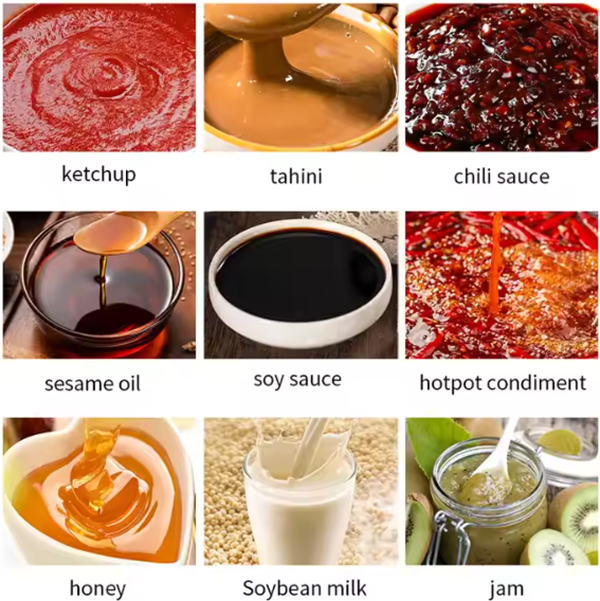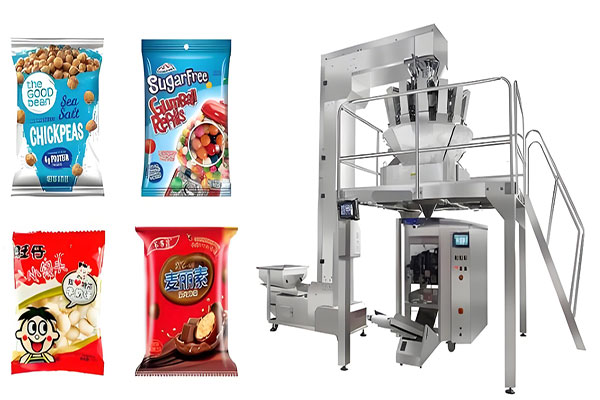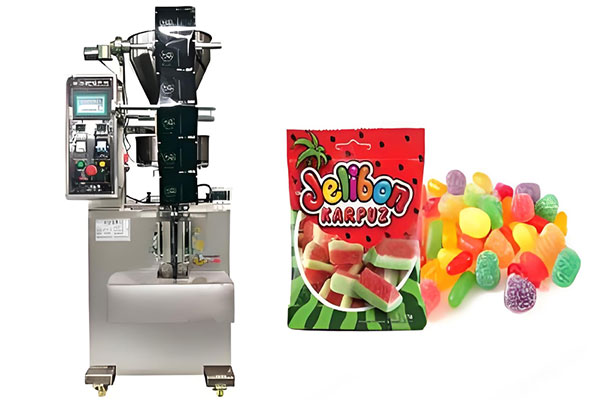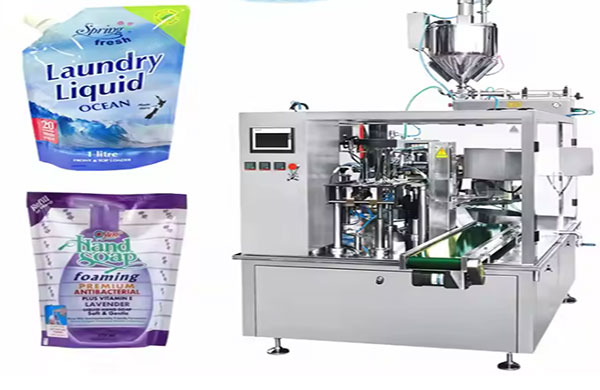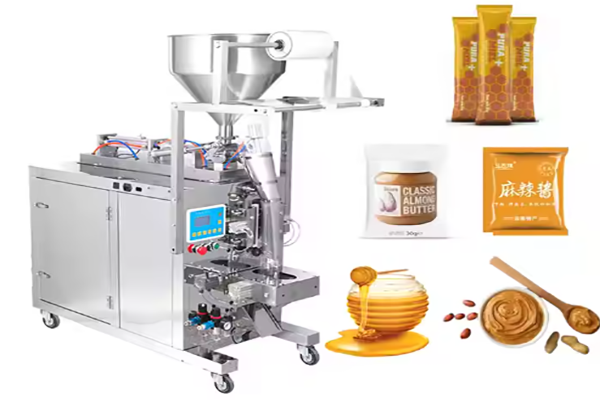
Liquid and Paste Packaging Machine
Liquid and Paste Packaging Machine is an important equipment in modern automated production lines. Its production capacity is generally 1,000 to 8,000 bags per hour. The price starts from US$2,000, and high-end models cost more than US$9,000. Filling Range: 5-1000 ml Packaging Speed: 10-40 bags/minute Metering Method: Piston-type Machine Material: Stainless Steel
What is Liquid and Paste Packaging Machine?
Liquid and Paste Packaging Machine utilizes an advanced PLC control system and a POD touchscreen interface for easy operation. The easy-to-use touch panel can package 40-120 bags per minute and features automatic filling and sealing capabilities. This compact packaging machine accurately measures and dispenses free-flowing products, making it suitable for packaging liquids and pastes such as detergents and milk.
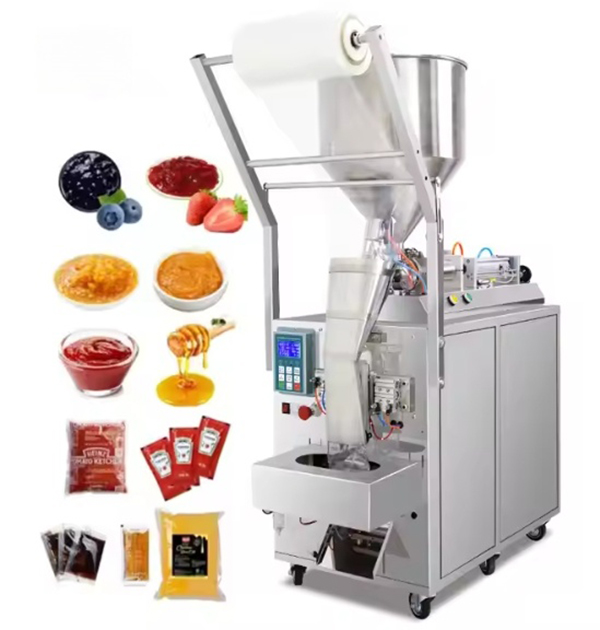
The Liquid and Paste Packaging Machine is used for metering, filling, and sealing liquids and semi-solid materials. Highly fluid liquids such as beverages and soy sauce are well-suited to flow meters or gravity metering. Pastes such as toothpaste and jam are more viscous and are typically dispensed using piston or screw pumps. Liquid and paste packaging machines are fast and hygienic. We offer a variety of machine types, including piston pumps, screw pumps, and flowmeters, to meet diverse packaging specifications and industry needs. Prices start at $2,000, with high-end models priced around $9,000.
Liquid and Paste Packaging Machine Video
Liquid and Paste Packaging Machine Parts
| Name | Function |
| Control panel | You can set packing speed, language, volume, temperature, sealing time, etc. |
| Film pulling device | It precisely controls the bag length. |
| Refluk device | When the machine works, the yellow value is open. The excess liquid will return. |
| Ribbon coding machine | It can realize automatical coding on the bags. |
| UV lamp sterilization roll film | Automatically sterilize, stretch and seal single-layer film. |
| Heat-sealed insulating cloth | The PE film is relatively thin, and it cannot direct contact with the cutter. |
What types of liquid and paste packaging machine are available?
Liquid and Paste Packaging Machines include vertical form-fill-seal machines, piston-type machines, servo-type machines, and other models. These machines cover a wide range of materials from low viscosity to high viscosity, and are suitable for packaging in bottles, tubes, bags, and cups. The touch panel is easy to operate and can meet different production capacity and manual and automation requirements.
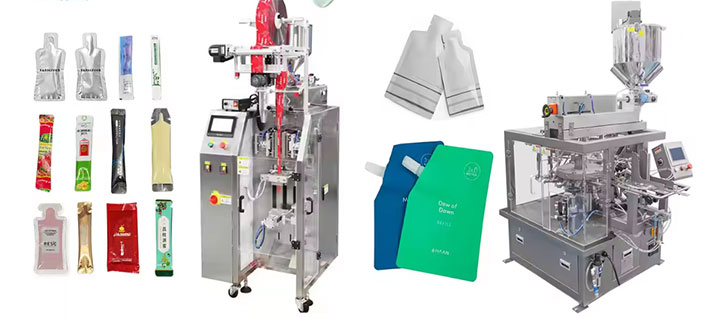
Equipment for high-speed, automated small pouch production
Fully automatic stand-up pouch packaging machine: This is a classic high-speed solution for small pouch packaging. Starting with the film roll, the entire process is fully automated, eliminating the need for manual handling of individual bags. Adding a multi-head weigher (for granules) or a multi-head pump (for liquids) significantly increases speed. It is the absolute workhorse for small sample bag production in the modern food and daily chemical industries.
High-speed rotary liquid filling machine: For small bottles and cans, the rotary multi-station filling line offers extremely fast speeds. Combined with automatic bottle loading, capping, and labeling, it achieves extremely high production capacity.
Equipment suitable for a variety of bag styles and high-end finishes
Stand-up pouch packaging machine with customized molds: By replacing the bag making unit, the vertical packaging machine can easily produce a variety of bag styles, including three-side seals, four-side seals, back seals (pillow bags), bags with hanging holes, and custom-shaped trims. Combined with high-quality printed film, it can create a very high-end appearance.
Paste filling and sealing machine: Tubes themselves are a classic "high-end" packaging format. Filling and sealing machines can create exquisite folded seals (such as crow's feet and square shapes) and can be combined with hot stamping and coding techniques. They are commonly used in the cosmetics and pharmaceutical industries, significantly enhancing the quality of products.
Servo-driven liquid filling machines: These machines utilize servo motors for more precise motion control and can handle a variety of unique bottle shapes. They provide a stable, drip-free filling process, maintaining a clean and aesthetically pleasing packaging. They are suitable for high-end skincare products, perfumes, and other products.
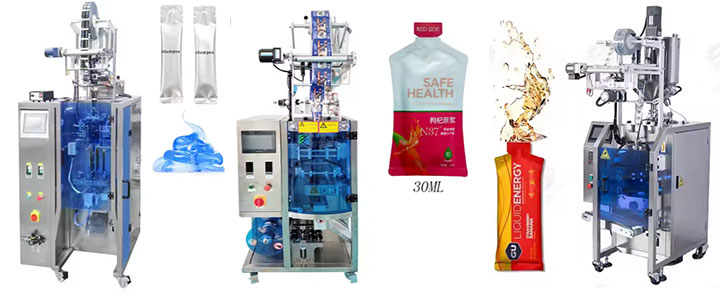
Equipment suitable for budget-friendly, small-batch, or manual operations
Semi-automatic/benchtop piston fillers or peristaltic pump fillers: These machines are inexpensive and simple in design. They typically require manual bottle placement and a foot pedal or button to initiate filling. They are ideal for startups, labs, small-batch production, or as a supplement to large production lines. They are also easy to clean when changing products.
Manual sealers (with semi-automatic filling): If the packaging format is pre-made bags, a simple measuring cup or semi-automatic filler can be used to fill the bags first, followed by a manual or foot-operated sealer. This is the most economical method, but speed and consistency rely entirely on manual labor.
Economical Single-Head Paste Filling Machine: For small batches of soft tube products, single-head, easy-to-operate filling and sealing machines are available. These machines are significantly cheaper than fully automatic models and can meet basic production needs.
What are the parameters of liquid and paste packaging machine?
| Models | VPSGG6/8-200L |
| Items included | Bag-feeding packaging machine, liquid (sauce) meter,mixing tank |
| Bag type |
Pouch bags/Doybags (with or without zippers), flat bags (3 side sealing, 4 side sealing, handbags, zipper bags), paper bags and other composite bags |
| Bag size | Width:100-210mm Length:100-450mm(Could be customized) |
| Weighing range scope | 10-1500g(could be customized) |
| Packing Speed | 25-60 bag/min(Its speed is determined by the product itself and the filling weight) |
| Packaging accuracy | ±1% |
| Voltage/power | 380V50HZ/60HZ 5KW |
| Compressed air consumption | 0.8m³/min(Provided by the user) |
| Packaging form |
Heat sealing note: different models of packaging machines need to be selected according to bag type, bag size and other parameters. |
What are the Advantages of Liquid and Paste Packaging Machines?
Made of stainless steel, these Liquid and Paste Packaging Machines are highly adaptable to various liquid and paste types. They offer a wide range of bag types, compatible with various bag materials, and customizable packaging capacities, resulting in high throughput and time-saving integrated production.
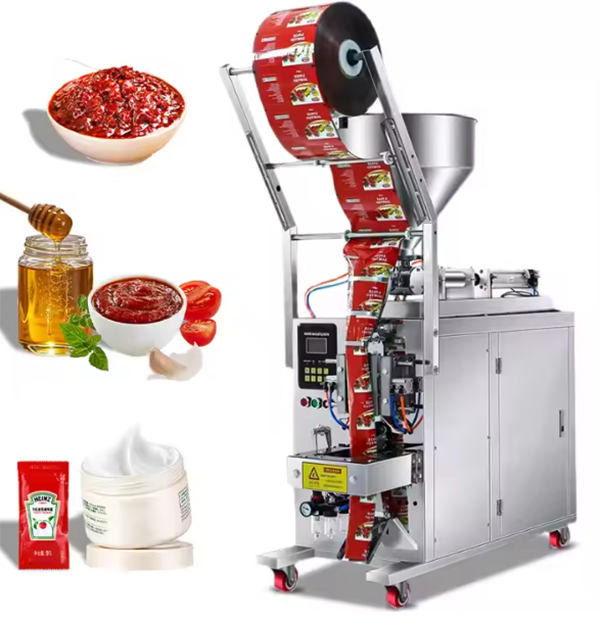
Material Compatibility: They can handle liquids of varying viscosities (such as water, oil, and juice) and pastes (such as sauces, cosmetics, and ointments), encompassing a wide range of applications. Machine Material: Made of stainless steel (such as 304/316) or food-grade plastic, it is corrosion-resistant, easy to clean, and meets hygiene standards.
Packaging Bag Type: Supports a variety of bag types, including stand-up pouches, four-side seal pouches, and back-seal pouches, to meet different product requirements.
Packaging Bag Material: Compatible with PE, PET/AL/PE, and composite films, ensuring sealing and shelf life.
Packaging Bag Size: Flexible adjustment to accommodate packaging needs from small bags (10ml) to large bags (1000ml).
Packaging Capacity: Precise metering with an error controllable within ±1%, suitable for various capacity requirements.
Output: High-speed models can reach over 60 bags/minute, improving production efficiency.
Functions: Equipped with automatic filling, sealing, coding, and counting functions, it supports integrated production lines for intelligent operation.
What is the difference between a liquid and paste packaging machine?
Liquid packaging machines utilize thin pipes and metering pumps, are suitable for low-viscosity materials, use PE/PP film, and offer high production capacity. Paste packaging machines utilize screws/pistons and thick pipes, are suitable for high-viscosity materials, use thick film or hoses, and feature agitation/heating, resulting in lower production capacity. The specific differences between Liquid and Paste Packaging Machine are as follows:
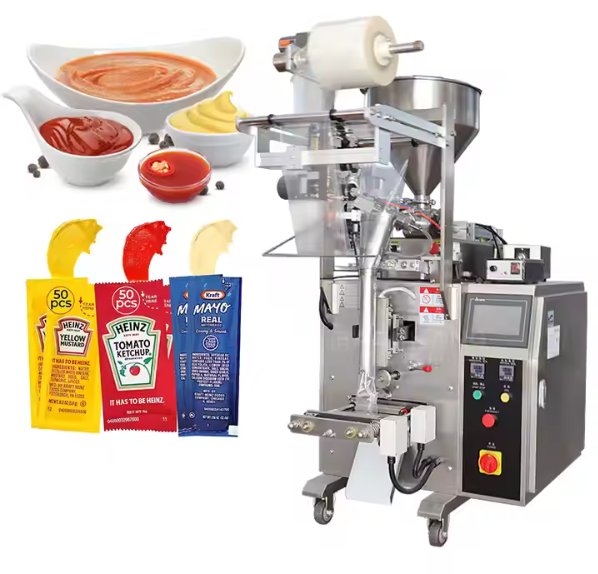
Structure: Liquid packaging machines are equipped with liquid metering pumps or flow control systems, have thin pipes, and are suitable for highly fluid materials. Paste packaging machines, on the other hand, utilize screw or piston propulsion mechanisms, are suitable for high-viscosity materials, have thicker pipes, and are more resistant to clogging.
Function: Liquid packaging machines are suitable for low-viscosity materials such as water and beverages, focusing on flow rate control. Paste packaging machines can handle high-viscosity materials such as chili sauce and toothpaste, emphasizing pressure delivery and precision, and often equipped with agitation or heating to maintain fluidity.
Packaging Bag Material: Liquid packaging often uses PE/PP composite film, emphasizing sealing properties. Paste packaging, which requires compression resistance, often uses thick aluminum-plastic composite film or stand-up bags. Bag
Type: Liquids are primarily packaged in pre-made bags or roll-wrap bags; pastes, due to their poor flowability, are more often packaged in stand-up pouches, flexible tubes, or large-diameter bags.
Productivity: Liquid machines, due to their good flowability, offer faster speeds, reaching over 60 bags/minute; paste machines, due to material properties, have lower production capacities, typically 20-40 bags/minute.
Liquid and Paste Packaging Machine Prices
Liquid and Paste Packaging Machine prices range from US$700 to US$9,000, depending primarily on the machine's functionality, production capacity, and degree of automation.
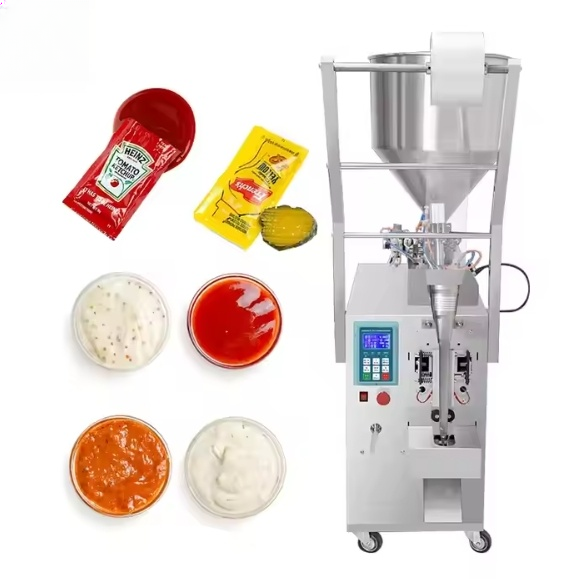
Small semi-automatic equipment, such as simple liquid filling machines or manual paste packaging machines, are suitable for laboratory use or small-batch production. They typically have a production capacity of 10-30 bottles/minute and provide basic metering and filling functions. Prices range from US$700 to US$2,500.
Medium-sized fully automatic equipment, such as four-side-seal liquid packaging machines or fully automatic paste filling machines, can produce 50-100 packages per minute, support continuous production, and are equipped with PLC control, automatic metering, and sealing functions. They are suitable for small and medium-sized businesses. Prices range from US$3,000 to US$8,000.
Large, high-speed production lines, such as multi-head fully automatic liquid filling machines or industrial-grade paste packaging lines, have a capacity exceeding 200 packages per minute and integrate high-precision sensing, intelligent control, and assembly line linkage, making them suitable for large-scale batch production. Prices are around US$9,000.
Liquid and Paste Packaging Machine Supplier
Our factory boasts advanced production equipment and years of industry experience, specializing in the design and manufacture of liquid and paste packaging machines. Our equipment is constructed of corrosion-resistant, durable stainless steel that meets food-grade standards. We support customization and can tailor packaging solutions for different volumes and viscosities to meet diverse customer needs. We also provide comprehensive after-sales service, earning the trust of our customers.
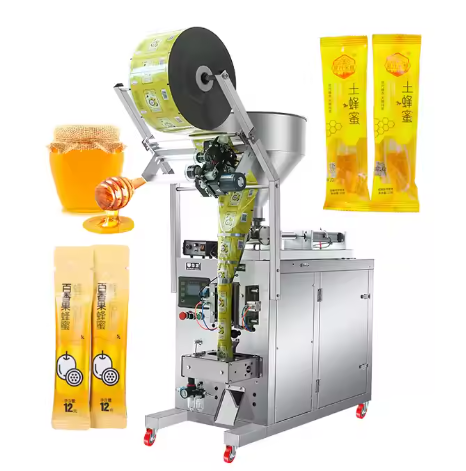
Liquid and Paste Packaging Machine Customer Case Studies
To improve production line efficiency, a food company installed a Liquid and Paste Packaging Machine for packaging viscous products such as sauces and condiments. The machine achieves a fill volume tolerance of ±1%, accommodates a wide range of container sizes, and reduces changeover time to 15 minutes. Customer feedback indicates that this machine not only eliminates previous issues with leaks and loose seals, but also reduces downtime for cleaning by 40% through its automated cleaning function, increasing daily production capacity by 30%. Furthermore, the intelligent touchscreen interface simplifies operation, shortens employee training by 50%, and significantly reduces labor costs. The machine has been operating stably for over 2,000 hours and has become a key component of the customer's core production line.
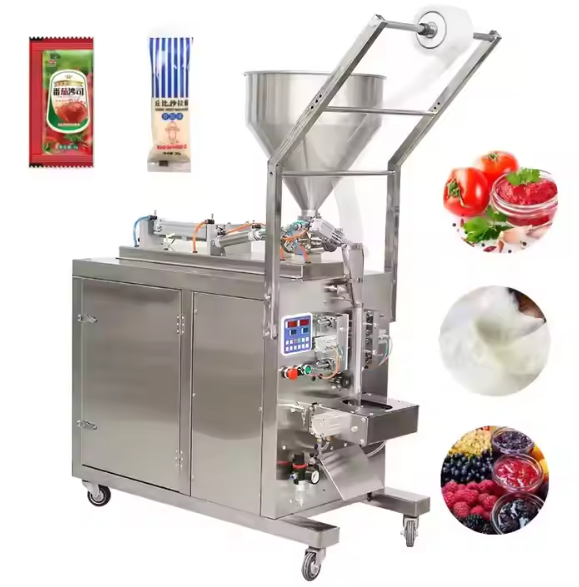
What are the Applications of Liquid and Paste Packaging Machines?
Liquid and Paste Packaging Machine are widely used across multiple industries. In the food industry, they are used to package beverages, sauces, and honey; in the pharmaceutical industry, they are used to fill liquid medicines and ointments; in the cosmetics industry, they are used to fill lotions, creams, and lotions; and in the chemical industry, they are used to package glues and lubricants. Different industries have different requirements for equipment. For example, the food industry emphasizes sanitary materials, while the pharmaceutical industry requires high precision and aseptic operation.
